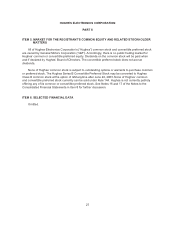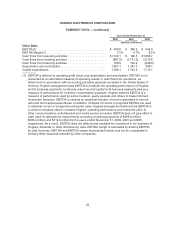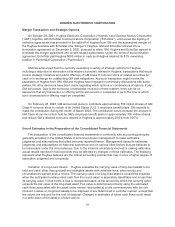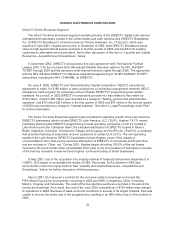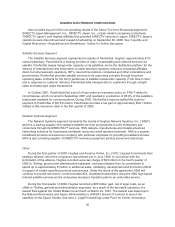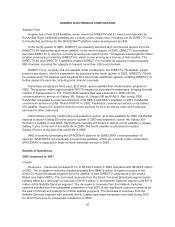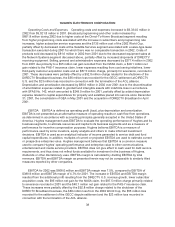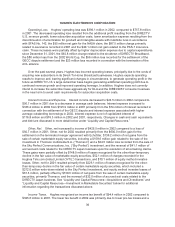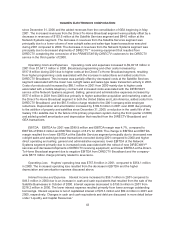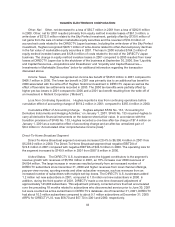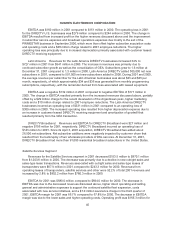DIRECTV 2002 Annual Report Download - page 46
Download and view the complete annual report
Please find page 46 of the 2002 DIRECTV annual report below. You can navigate through the pages in the report by either clicking on the pages listed below, or by using the keyword search tool below to find specific information within the annual report.HUGHES ELECTRONICS CORPORATION
Hughes adopted SFAS No. 142, “Goodwill and Other Intangible Assets,” on January 1, 2002.
SFAS No. 142 required that existing and future goodwill and intangible assets with indefinite lives not
be amortized, but written-down, as needed, based upon an impairment analysis that must occur at
least annually, or sooner if an event occurs or circumstances change that would more likely than not
result in an impairment loss. All other intangible assets are amortized over their estimated useful lives.
As a result, Hughes recognized amortization expense of $249 million for goodwill and intangible assets
with indefinite lives for the year ended December 31, 2001 for which there is no comparable amount in
2002. In addition, as a result of adopting SFAS No. 142, Hughes recorded a cumulative effect of
accounting change, net of taxes, of $681.3 million ($755.7 million pre-tax) as of January 1, 2002 in the
Consolidated Statements of Operations and Available Separate Consolidated Net Income (Loss)
primarily related to the write-off of goodwill at DLA and DIRECTV Broadband. See further discussion
under “Accounting Changes” below.
During the second and third quarters of 2001, Hughes announced a nearly 10% reduction of its
approximately 7,900 employees, excluding DIRECTV customer service representatives, located in the
United States. As a result, 750 employees across all business disciplines were given notification of
termination that resulted in an expense of $22.2 million in the second quarter of 2001 and $65.3 million
in the third quarter of 2001 for a total charge to “Selling, general and administrative expenses” of
$87.5 million. Of that charge, $80.0 million was related to employee severance benefits and
$7.5 million was for other costs primarily related to a remaining lease obligation associated with excess
office space and employee equipment. The remaining accrual amounted to $14.1 million at
December 31, 2002 and related to long-term employee severance benefits.
In addition to the significant operating gains and losses described above, Hughes has recognized
a number of significant non-operating gains and losses during the years ended December 31, 2002,
2001 and 2000. These transactions are more fully described below in “Liquidity and Capital
Resources—Acquisitions and Divestitures” and “Liquidity and Capital Resources—Investments in
Marketable Securities.”
In October 2001, Hughes reached a settlement with Raytheon Company (“Raytheon”) on a
purchase price adjustment related to the 1997 spin-off of Hughes’ defense electronics business and
the subsequent merger of that business with Raytheon. Under the terms of the settlement, Hughes
agreed to reimburse Raytheon for a portion of the original $9.5 billion purchase price. Hughes paid
$500 million of the settlement amount in October 2001 and the remainder, $134.2 million, was paid
during February 2002. In the third quarter of 2001, Hughes recorded a decrease to “Capital stock and
additional paid-in capital” of $574.2 million as a result of the settlement.
At December 31, 2002, Hughes had a cash balance of $1,128.6 million and unused debt capacity
of $1,532.9 million, which includes $248.9 million of debt capacity at PanAmSat. Included as part of
Hughes’ cash balance of $1,128.6 at December 31, 2002 was $784.0 million of cash at PanAmSat,
which is generally not available for use by Hughes. Hughes believes it has adequate liquidity to fund
cash requirements for its continuing operations in 2003 of about $200 million to $300 million. In
addition, in the first quarter of 2003, Hughes completed a series of financing transactions designed to
provide sufficient liquidity to fund Hughes’ business plan through cash flow breakeven. See further
discussion under “Liquidity and Capital Resources—Notes Payable and Credit Facilities” below.
On June 6, 2000, the GM Board of Directors (“GM Board”) declared a three-for-one stock split of
the GM Class H common stock. The stock split was in the form of a 200% stock dividend, paid on
June 30, 2000 to GM Class H common stockholders of record on June 13, 2000. As a result, the
numbers of shares of GM Class H common stock presented for all periods prior to the stock split have
been adjusted to reflect the stock split, unless otherwise noted.
36



